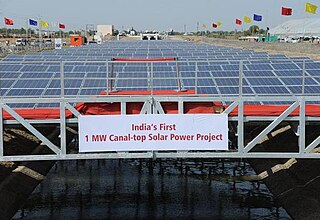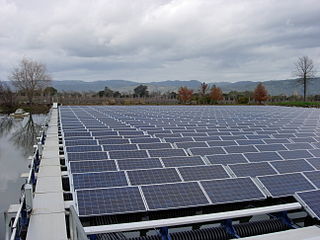
A solar canal is a canal fitted with solar panels, increasing their efficiency, and reducing evaporation and land usage. The first operative system was installed in Gujarat, India in 2014.

A solar canal is a canal fitted with solar panels, increasing their efficiency, and reducing evaporation and land usage. The first operative system was installed in Gujarat, India in 2014.
By placing solar panels above water, evaporation is lessened. Studies from the Canal Solar Power Project in India, show that the resulting shade helps reduce weeds, as well as de-weeding costs. The photovoltaic panels benefit from evaporative cooling. The panels remain cooler, thus reflecting less light and thereby absorbing more energy. [1] Because solar collectors are often built on arable land or natural ecosystems, solar canals could reduce land lost to energy production, as well as conflicts with farmers and other stakeholders. Furthermore, land acquisition costs and land-use permitting issues may be circumscribed, if canals are already in operation. [2] Irrigation systems may benefit, given that pumps would be located within easy access of a power source. [3]
A large project in Gujarat, India was completed in 2014. That project utilizes pre-existing irrigation canals, thereby saving land and water, while generating electricity. The project's success led to the initiation of many other solar canals in India. [4] The state of Gujarat has plans to build 19,000 kilometers of solar canals. [5]
The first phase of a large project in Lebanon called the “Beirut River Solar Snake” began in 2013 and was completed in 2015. [6] The project aimed to create solar power in a city where land costs are prohibitively high. [7]
The state of California is moving ahead with plans to build large scale solar canals. [8] The initial project is set to be completed in 2023. [9]
Former Secretary-General of the United Nations Ban Ki-moon visited Gujarat's solar canals and declared that they should be adopted globally. [10]
Solar canals are more costly to install than land-based solar collectors. They also incur higher maintenance costs. [4] Canals that are quite narrow or quite wide can add to the costs of solar canals. [11]
An autonomous building is a building designed to be operated independently from infrastructural support services such as the electric power grid, gas grid, municipal water systems, sewage treatment systems, storm drains, communication services, and in some cases, public roads.

Solar energy is radiant light and heat from the Sun that is harnessed using a range of technologies such as solar power to generate electricity, solar thermal energy, and solar architecture. It is an essential source of renewable energy, and its technologies are broadly characterized as either passive solar or active solar depending on how they capture and distribute solar energy or convert it into solar power. Active solar techniques include the use of photovoltaic systems, concentrated solar power, and solar water heating to harness the energy. Passive solar techniques include orienting a building to the Sun, selecting materials with favorable thermal mass or light-dispersing properties, and designing spaces that naturally circulate air.

Solar thermal energy (STE) is a form of energy and a technology for harnessing solar energy to generate thermal energy for use in industry, and in the residential and commercial sectors.

The Sardar Sarovar Dam is a concrete gravity dam built on the Narmada River near the town of Kevadiya, in Narmada District, in the Indian state of Gujarat. The dam was constructed to provide water and electricity to the Indian states of Gujarat, Madhya Pradesh, Maharashtra and Rajasthan.

India is the third largest producer of electricity in the world. During the fiscal year (FY) 2022–23, the total electricity generation in the country was 1,844 TWh, of which 1,618 TWh was generated by utilities.

Solar-powered pumps run on electricity generated by photovoltaic (PV) panels or the radiated thermal energy available from collected sunlight as opposed to grid electricity- or diesel-run water pumps. Generally, solar-powered pumps consist of a solar panel array, solar charge controller, DC water pump, fuse box/breakers, electrical wiring, and a water storage tank. The operation of solar-powered pumps is more economical mainly due to the lower operation and maintenance costs and has less environmental impact than pumps powered by an internal combustion engine. Solar pumps are useful where grid electricity is unavailable or impractical, and alternative sources do not provide sufficient energy.

Many countries and territories have installed significant solar power capacity into their electrical grids to supplement or provide an alternative to conventional energy sources. Solar power plants use one of two technologies:

Wind power in India has significantly increased its generation capacity in recent years. As of 31 December 2023, the total installed wind power capacity was 44.736 gigawatts (GW), the fourth largest installed wind power capacity in the world. Wind power capacity is mainly spread across the southern, western, and northwestern states.

India's solar power installed capacity was 73.32 GWAC as of 31 December 2023.
For solar power, South Asia has the ideal combination of both high solar insolation and a high density of potential customers.

Solar power has been growing rapidly in the U.S. state of California because of high insolation, community support, declining solar costs, and a renewable portfolio standard which requires that 60% of California's electricity come from renewable resources by 2030, with 100% by 2045. Much of this is expected to come from solar power via photovoltaic facilities or concentrated solar power facilities.
Ethiopia is called the water tower of Africa due to its combination of mountainous areas with a comparatively large share of water resources in Africa. Only a fraction of this potential has been harnessed so far, 1% at the beginning of the 21st century. In order to become the powerhouse of Africa, Ethiopia is actively exploiting its water resources by building dams, reservoirs, irrigation and diversion canals and hydropower stations. The benefits of the dams are not only limited to hydropower. Many dams are multi-purpose dams that are also designed to provide water for irrigation, drinking water and flood control. However, hydropower is expected to be the main benefit of the dams.
The South San Joaquin Irrigation District (SSJID), located in Southern San Joaquin County, California, is a non-profit utility that provides irrigation water and domestic water in the Central Valley of California along with hydroelectric power.

A photovoltaic power station, also known as a solar park, solar farm, or solar power plant, is a large-scale grid-connected photovoltaic power system designed for the supply of merchant power. They are different from most building-mounted and other decentralized solar power because they supply power at the utility level, rather than to a local user or users. Utility-scale solar is sometimes used to describe this type of project.

The Narmada Canal is a contour canal in Western India that brings water from the Sardar Sarovar Dam to the state of Gujarat and then into Rajasthan state. The main canal has a length of 532 kilometres (331 mi). It is the second longest canal in India and the largest canal by water carrying capacity. The main canal is connected with 42 branch canals providing irrigation to 2,129,000 hectares farmland. The canal is designed to transfer 9.5 million acre-feet water annually from the Narmada Basin to areas under other river basins in Gujarat and Rajasthan..

The Canal Solar Power Project is a solar canal project launched in Gujarat, India, to use the 532 km (331 mi) long network of Narmada canals across the state for setting up solar panels to generate electricity. It was the first ever such project in India. This project has been commissioned by SunEdison India.

Agrivoltaics,agrophotovoltaics,agrisolar, or dual-use solar is the simultaneous use of areas of land for both solar panels and agriculture. The technique was originally conceived by Adolf Goetzberger and Armin Zastrow in 1981, Agrivoltaics can refer to different methods of combining crops with solar panels, from conventional solar panels placed on top of crops, to greenhouses made of semi-transparent PV panels.

Floating solar or floating photovoltaics (FPV), sometimes called floatovoltaics, are solar panels mounted on a structure that floats on a body of water, typically a reservoir or a lake such as drinking water reservoirs, quarry lakes, irrigation canals or remediation and tailing ponds. A growing number of such systems exist in China, France, Indonesia, India, Japan, South Korea, the United Kingdom, Singapore, Thailand, and the United States.
The Gujarat Hybrid Renewable Energy Park is an under construction renewable energy park located near Vighakot village near Kutch district of Gujarat, India. It is expected to generate 30 gigawatt electricity from both solar panels and wind turbines when completed, over an area of 72,600 hectares (726 km2).
Pradhan Mantri Kisan Urja Suraksha evam Utthaan Mahabhiyan (KUSUM) Yojana launched on March 2019 by the Government of India to increase the income of farmers and provide sources for irrigation and de-dieselisation the agricultural sector. The PM-Kusum scheme approved in March 2019 and guidelines were prepared in July 2019 by the Ministry of New and Renewable Energy (MNRE) for setting up solar pumps and other new power plants across the country.
This article needs additional or more specific categories .(August 2022) |